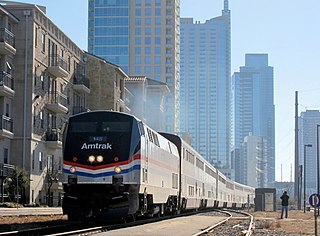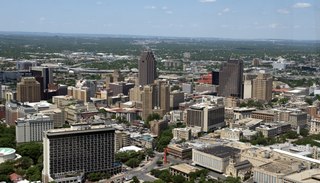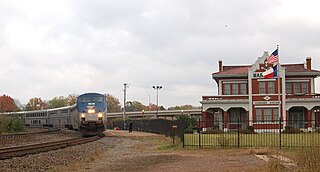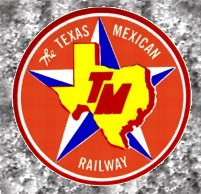
The Texas Eagle is a long-distance passenger train operated daily by Amtrak on a 1,306-mile (2,102 km) route between Chicago, Illinois, and San Antonio, Texas, with major stops in St. Louis, Little Rock, Dallas, Fort Worth, and Austin. Three days per week, the train joins the Sunset Limited in San Antonio and continues to Los Angeles via El Paso and Tucson. The combined 2,728-mile (4,390 km) route is the longest in the United States and the second-longest in the Americas, after the Canadian.

Dallas Union Station, officially Eddie Bernice Johnson Union Station, also known as Dallas Union Terminal, is a large intermodal railroad station in Dallas, Texas. It is the third busiest Amtrak station in Texas, behind Fort Worth Central Station and San Antonio station. It serves DART light rail Blue and Red lines, Trinity Railway Express commuter rail and Amtrak inter-city rail. It is located on Houston Street, between Wood and Young Streets, in the Reunion district of Downtown Dallas. The structure is a Dallas Landmark and is listed on the National Register of Historic Places.

South Texas is a geographic and cultural region of the U.S. state of Texas that lies roughly south of—and includes—San Antonio. The southern and western boundary is the Rio Grande, and to the east it is the Gulf of Mexico. The population of this region is about 4.96 million according to the 2017 census estimates. The southern portion of this region is often referred to as the Rio Grande Valley. The eastern portion along the Gulf of Mexico is also referred to as the Coastal Bend.

The Missouri Pacific Railroad, commonly abbreviated as MoPac, was one of the first railroads in the United States west of the Mississippi River. MoPac was a Class I railroad growing from dozens of predecessors and mergers. In 1967, the railroad operated 9,041 miles of road and 13,318 miles of track, not including DK&S, NO&LC, T&P, and its subsidiaries C&EI and Missouri-Illinois.

The Texas and Pacific Railway Company was created by federal charter in 1871 with the purpose of building a southern transcontinental railroad between Marshall, Texas, and San Diego, California.

Marshall station is a railroad station in Marshall, Texas. It is served by Amtrak, the national railroad passenger system, which operates the Texas Eagle through Marshall each day, with service north to Chicago and west-southwest to Dallas, San Antonio and Los Angeles. The station also houses the Texas and Pacific Railway Depot & Museum.

The Texas Mexican Railway was a short line railroad in the U.S. state of Texas operating between Corpus Christi and the Texas Mexican Railway International Bridge in Laredo, Texas. It is often referred to as the Tex Mex, or Tex Mex Railway.

El Paso Union Depot is an Amtrak train station in El Paso, Texas, served by the Texas Eagle and Sunset Limited. The station was designed by architect Daniel Burnham, who also designed Washington Union Station in Washington, D.C., which was built between 1905 and 1906 and was added to the National Register of Historic Places in 1971.

Austin station is a train station located just west of downtown Austin, Texas, United States. The station is served by Amtrak's Texas Eagle route, which runs north to Chicago and west to Los Angeles. Trains pass daily at 9 am and 5 pm.

San Antonio station is an Amtrak railroad station located on the eastern portion of Downtown San Antonio, in San Antonio, Texas.
Sanderson station is an Amtrak railway station serving the small West Texas town of Sanderson. The unstaffed station is located alongside West Downie Street in the southwest corner of the town. The station accommodates travelers who use the combined Sunset Limited and Texas Eagle, operating between Los Angeles and New Orleans or Chicago, respectively.

Pomona–Downtown station, is a train station in Pomona, California, United States. It is primarily served by Metrolink’s Riverside Line commuter rail service. The station is also served by limited Amtrak long-distance inter-city rail service, with the thrice-weekly round trip of the combined Sunset Limited/Texas Eagle. It is owned and operated by the city of Pomona.

Texarkana Union Station is a historic train station in the Texarkana metropolitan area serving Amtrak, the United States' national passenger rail system. The Arkansas-Texas border bisects the structure; the eastern part, including the waiting room and ticket office, are in Texarkana, Arkansas, but the western part is in Texarkana, Texas, meaning stopped trains span both states. The station was built in 1928 and was added to the U.S. National Register of Historic Places in 1978. Today it is the second busiest Amtrak station in Arkansas.

Longview station is a train station in Longview, Texas, United States. It is served by Amtrak and was originally built by the Texas & Pacific Railway.

Mineola station is a station in Mineola, Texas, United States, currently served by Amtrak's Texas Eagle. The station was originally built in 1906 by the Texas & Pacific Railway and also used by the Missouri Pacific Railroad.

Temple is a train station in Temple, Texas, United States served by Amtrak, the national railroad passenger system. The station was originally built as an Atchison, Topeka and Santa Fe Railway depot. East of the station on another railroad line through Temple, a former Missouri-Kansas-Texas Railroad depot can be found, as the nexus for trains bound for Waco, San Antonio and Houston.

The Inter-American was a passenger train operated by Amtrak between Chicago and Laredo, Texas. Its route changed over time and was eventually replaced by the Texas Eagle.

Hope station is a passenger rail station in Hope, Arkansas. The station is located on Amtrak's Texas Eagle line. Trains run daily between Chicago, Illinois, and San Antonio, Texas, and continue to Los Angeles, California, 2,728 miles (4,390 km) total, three days a week.

The Newport station, also known as Missouri-Pacific Depot-Newport, is a historic railroad station at Walnut and Front Streets in Newport, Arkansas. It is a long rectangular single-story brick and stucco topped by a hip roof, whose wide eaves are supported by large Italianate knee brackets. Its roof, originally slate, is now shingled, detracting from its original Mediterranean styling. A telegrapher's bay extends above the roof line on the track side of the building. The building was built in 1904 by the Missouri-Pacific Railroad to handle passenger and freight traffic.

The Águila Azteca was a passenger train between Mexico City and Nuevo Laredo, and formerly to San Antonio station, which was operated by Ferrocarriles Nacionales de México.



















